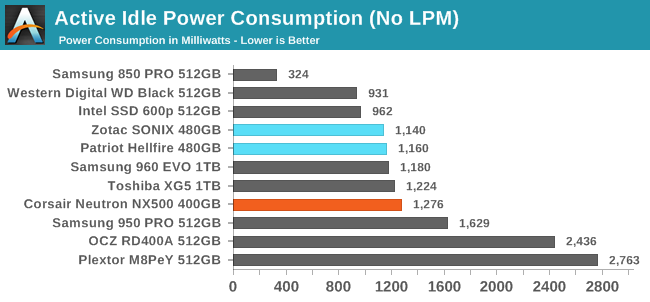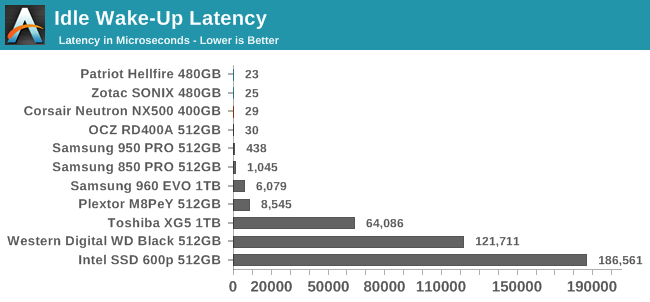The Corsair Neutron NX500 (400GB) PCIe SSD Review: Big Card, Big Pricetag
by Billy Tallis on August 16, 2017 10:00 AM ESTPower Management
Real-world client storage workloads leave SSDs idle most of the time, so the active power measurements presented earlier in this review only account for a small part of what determines a drive's suitability for battery-powered use. Especially under light use, the power efficiency of a SSD is determined mostly be how well it can save power when idle.
Idle power management for NVMe SSDs is far more complicated than for SATA SSDs. NVMe SSDs can support several different idle power states, and through the Autonomous Power State Transition (APST) feature the operating system can set a drive's policy for when to drop down to a lower power state. There is typically a tradeoff in that lower-power states take longer to enter and wake up from, so the choice about what power states to use may differ for desktop and notebooks.
We report two idle power measurements. Active idle is representative of a typical desktop, where none of the advanced PCIe link or NVMe power saving features are enabled and the drive is immediately ready to process new commands. The idle power consumption metric is measured with PCIe Active State Power Management L1.2 state enabled and NVMe APST enabled.


The active idle power consumption of the NX500 is clearly higher than the other two Phison E7 drives, most likely due to the extra DRAM on the NX500. Idle power saving modes are still broken with the combination of this testbed and the Phison E7, but at least the NX500 isn't drawing as much power as the Patriot Hellfire did. Given the intended audience, it is unlikely that NX500 users would even attempt to use the low power modes.

With no drive-level sleep state to wake up from, the idle wake-up latency of the NX500 is the minimal time it takes to switch the PCIe link back to full power.










45 Comments
View All Comments
Exodite - Wednesday, August 16, 2017 - link
I'm looking forward to the day I can read a SSD review and not come away thinking "...or just buy a Samsung".Not that I begrudge them top spot, they've clearly put the work into it, but as consumers we'd be better served if at least /someone/ else were competing on, like, any metric.
Ej24 - Wednesday, August 16, 2017 - link
Crucial used to be in the game back when Sata SSD's were king, then they just never released another MLC drive, nor any consumer nvme drives. So yeah, Samsung is definitely unchallenged now. Though that Toshiba xg5 kept up well in the destroyer benchmark.coolhardware - Wednesday, August 16, 2017 - link
Agreed. Samsung has been at the top for so long it is just boring.Kudos to Samsung though for making some fast and reliable SSDs at a reasonable price point.
Lolimaster - Wednesday, August 16, 2017 - link
I think we got more chances to see GloFo AMD branded SSD better than the 850 than waiting for the known competitors.Samus - Wednesday, August 16, 2017 - link
Crucial is still in the game. They just can't compete with Samsung on performance. Nobody can.But in my experience, Crucial/Micron drives are slightly more reliable that Samsung (obviously excusing the flawed 840\840 EVO) especially in regard to power loss scenarios. That's why you continue to see more Micron drives in enterprise and business PC's than any other brand (except perhaps Sandisk, in which case they are often the same Marvell controller so the differentiating factor comes down to firmware and in-flight data protection)
It's really hard to consider anything else when looking at "new" drives. Samsung and Crucial/Micron are really at the top. Sandisk is decent, but not cost competitive at the high end, and OCZ's has had some good drives for the price lately, but why gamble?
And if you are looking for cheap MLC drives, older Intel drives are still the best bet. I still have a soft spot for SSD320's and SSD710's if you can live with the 3Gbps interface they are bulletproof and incredibly cheap on fleabay.
DigitalFreak - Wednesday, August 16, 2017 - link
"That's why you continue to see more Micron drives in enterprise and business PC's than any other brand (except perhaps Sandisk, in which case they are often the same Marvell controller so the differentiating factor comes down to firmware and in-flight data protection)"Maybe it's the particular vendor, but the Dell and Cisco equipment I deal with in both the server and desktop space use mainly Samsung, with some Toshiba XG series on the client side.
tipoo - Wednesday, August 16, 2017 - link
It's maybe ironic the only one challenging them on SSD speed isn't selling SSDs outside their own systems, i.e the last custom Apple SSD controller.tipoo - Wednesday, August 16, 2017 - link
Actually I'd love to see that put through this suite.extide - Wednesday, August 16, 2017 - link
Well at least I can be satisfied knowing I made a good investment buying my 1TB 960 EVO -- heck I think I paid around $400 - $450 or so for it -- cheaper than the 800GB version of this. It makes reviews boring but at the same time it sucks spending good money on something and then seeing something cheaper and faster released shortly after, although I do agree that we need to see some competition.beginner99 - Thursday, August 17, 2017 - link
Yeah. Perfromance is one thing but price another and this drive is clearly overpriced. If you want me to use a pcie-card ssd you better deliver something special but this fails.What's missing is a strady-state bench. First the large spare area gets praised but then no steady-state data? IMHO that is usually the most important aspect of the review, the actual performance the drive will have not some "marketing" numbers.